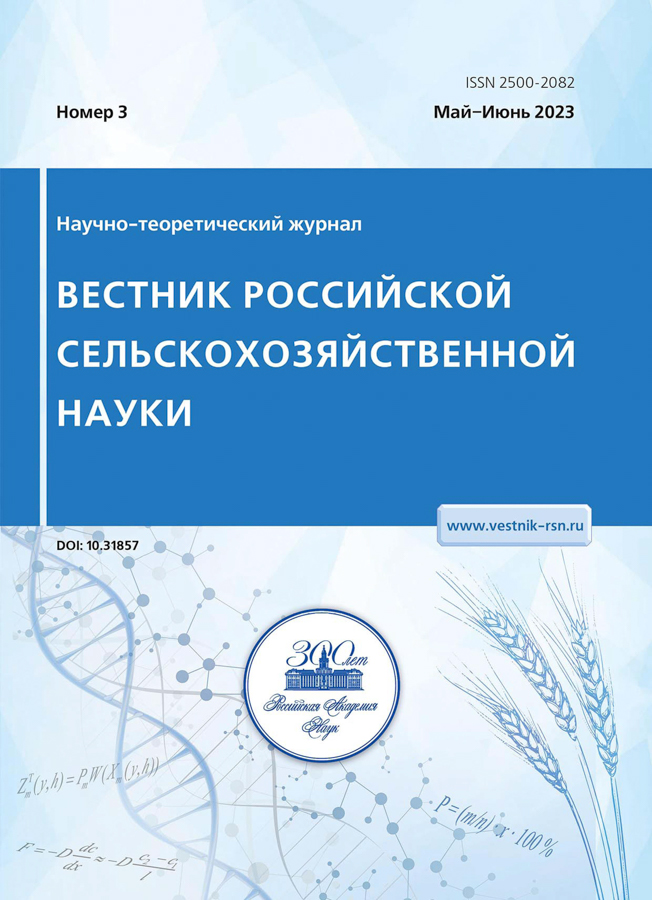Spring wheat and triticale varieties productivity in risk farming area
- Autores: Zenkina K.V1, Aseeva T.A1
-
Afiliações:
- Federal State Budgetary Institution of Science Khabarovsk Federal Research Center of the Far Eastern Branch of the Russian Academy of Sciences Far Eastern Agricultural Research Institute
- Edição: Nº 3 (2023)
- Páginas: 13-15
- Seção: ARTICLES
- URL: https://snv63.ru/2500-2082/article/view/657244
- DOI: https://doi.org/10.31857/2500-2082/2023/3/13-15
- EDN: https://elibrary.ru/FIYMUH
- ID: 657244
Citar
Texto integral
Resumo
The studies were carried out in 2015-2022 at the Far Eastern Research Institute of Agriculture (Khabarovsk Territory). The object of study is released varieties of spring wheat (Khabarovchanka, Lira-98, Anfeya) and spring triticale (Ukro, Rovnya, Grebeshok). Agrometeorological conditions during the years of research were varied: 2015, 2016, 2019, 2022 - with excessive moisture, 2021 - insufficient precipitation, 2017, 2018 - within the average annual values. As a result of the research, it was found that under favorable conditions, the yield of triticale varieties was 45.2-79.8 centners per hectare, under the influence of limited factors, this indicator decreases by 3.6-5.0 times, and the formation of the productivity of wheat samples in the region is more stable. (average yield was 33.6-51.4 сentners per hectare). In terms of grain quality, there were differences in grain crops - wheat varieties accumulate a high amount of protein in grain (more than 15 %), triticale samples have the highest content of lysine in grain (more than 400 mg/%). It was revealed that the signs of productivity in the zone of risky farming in triticale and wheat varieties are inversely correlated with agrometeorological environmental conditions. High correlations were noted between: yield and heat in July for the triticale variety Grebeshok (r=0.75), grain size and heat in May and July for samples of triticale Grebeshok and Rovnya (r=0.74 and r=0.73 respectively), yield and amount of precipitation in June for wheat varieties Khabarovchanka and Lira-98 (r= -0.77 and r= -0.78 respectively), weight of 1000 grains and surface air temperature for variety Lira-98 (r= - 0.78).
Palavras-chave
Sobre autores
K. Zenkina
Federal State Budgetary Institution of Science Khabarovsk Federal Research Center of the Far Eastern Branch of the Russian Academy of Sciences Far Eastern Agricultural Research Institute
T. Aseeva
Federal State Budgetary Institution of Science Khabarovsk Federal Research Center of the Far Eastern Branch of the Russian Academy of Sciences Far Eastern Agricultural Research Institute
Email: aseeva59@mail.ru
Bibliografia
- Амунова О.С., Волкова Л.В., Зуев Е.В., Харина А.В. Исходный материал для селекции мягкой яровой пшеницы в условиях Кировской области // Аграрная наука Евро-Северо-Востока. 2021. Т. 22. № 5. С. 661-675.
- Владимирова Е.С. Корреляционный анализ исходного материала для селекции мягкой яровой пшеницы в условиях Центральной Якутии // Известия Оренбургского государственного аграрного университета. 2020. № 5. С. 31-37.
- Воротников И.Л., Розанов А.В., Богатырев С.А., Ключиков А.В. Методологические особенности долгосрочного прогнозирования урожайности зерновых культур // Аграрный научный журнал. 2022. № 11. С. 34-37.
- Губанова Е.В., Кочергина Т.В., Хохолуш М.С. Пространственная организация зернового производства в РФ // Вестник НГИЭИ. 2022. № 8. С. 113-122.
- Кинчаров А.И. Таранова Т.Ю., Демина Е.А., Чекмасова К.Ю. Селекционная оценка признака масса 1000 зерен в засушливых условиях // Успехи современного естествознания. 2020. № 5. С. 7-12.
- Ким Л.В., Назарова А.А. Анализ земель аграрного сектора Хабаровского края в разрезе муниципальных образований // Международный научно-исследовательский журнал. 2022. № 2. С.80-83.
- Назарова А.А. Аграрный сектор Хабаровского края в современных экономических условиях // Международный научно-исследовательский журнал. 2022. № 8. С. 1-4.
- Пасынков А.В., Завалин А.А., Пасынкова Е.Н., Андреев В.Л. Сравнительная оценка различных методов прогноза содержания белка в зерне пшеницы // Российская сельскохозяйственная наука. 2021. № 3. С. 22-27.
- Ручкина А.В., Ушаков Р.Н., Елизаров А.О., Амелина Т.Ю. Дискриминантный анализ в оценке урожайности зерновых культур на агросерых почвах // Вестник Рязанского государственного агротехнологического университета им. П.А.Костычева. 2020. № 1. С. 121-126.
- Соболев В.А., Батудаев А.П., Цыбиков Б.Б. и др. Влияние погодных условий на урожайность зерновых культур в степной зоне Бурятии // Вестник Бурятской государственной сельскохозяйственной академии им. В.Р.Филиппова. 2021. № 3. С. 138-143.
- Тысленко А.М., Зуев Д.В. Оценка сортов яровой тритикале Владимирской селекции по крупности семян // Международный журнал гуманитарных и естественных наук. 2022. № 9. С. 49-52.
- Шахова О.А. Особенности формирования урожайности зерновых культур в условиях северной лесостепи Тюменской области // Известия Оренбургского государственного аграрного университета. 2020. № 6. С. 26-31.
Arquivos suplementares










